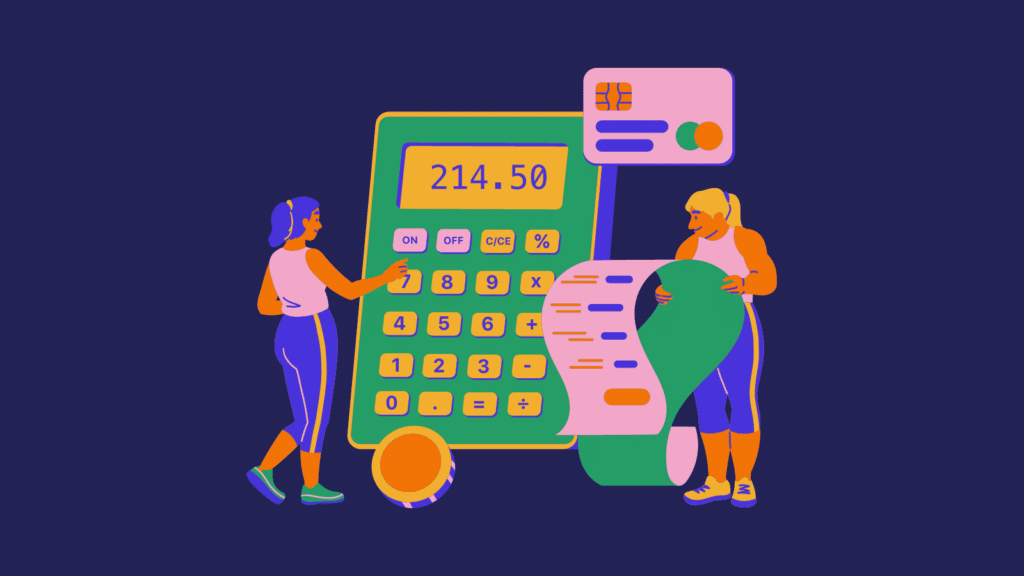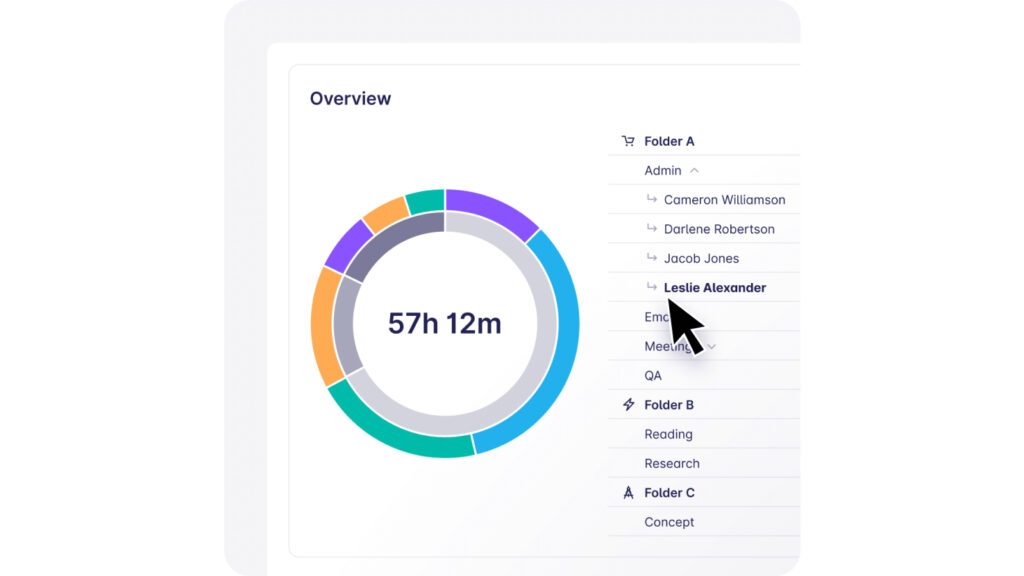Was sind abrechenbare Stunden? Ihre Bedeutung für deine Einkünfte
Abrechenbare Stunden sind die für eine Aufgabe oder ein Projekt aufgewendeten Arbeitsstunden, die einem Kunden in Rechnung gestellt werden können. Das Konzept ist einfach: Je mehr abrechenbare Zeit erfasst wird, desto mehr können Sie Ihren Kunden in Rechnung stellen. Deshalb ist ein umfassendes Verständnis dessen, was abrechenbare Stunden sind und wie die Erfassung abrechenbarer Zeiten funktioniert, von entscheidender Bedeutung für die Steigerung der Rentabilität Ihres Unternehmens.
In diesem Artikel erfahren Sie mehr:
- Was sind abrechenbare Stunden und nicht abrechenbare Stunden (mit Beispielen)
- Warum Sie fakturierbare und nicht fakturierbare Stunden erfassen sollten
- Wie Sie abrechenbare und nicht abrechenbare Zeit erfassen, um Ihren Abrechnungsprozess zu verbessern
- Wie viele abrechenbare Stunden Sie arbeiten sollten
- Wie man die abrechenbaren Stunden erhöht

Maximieren Sie Ihren Umsatz, indem Sie jede abrechenbare Minute verfolgen
"Habe ich wirklich so viel zu wenig berechnet? Es hat mir die Augen geöffnet, als ich sah, wie viel diese Stunden - es ist ja nur ein schneller Job - ausmachten." - Debi H., Digital Marketer
Was sind abrechenbare Stunden?
Abrechenbare Stunden sind die tatsächlich an einer Aufgabe oder einem Kundenprojekt geleisteten Stunden, die dem Kunden in Rechnung gestellt werden können. Sie werden dem Kunden in der Regel zu einem vereinbarten Stundensatz in Rechnung gestellt und sind entscheidend für die Berechnung der Gesamtkosten der Dienstleistung. Abrechenbare Aufgaben umfassen alle Arten von Kundenarbeit, einschließlich Kundenanrufe und -besprechungen.
Beispiele für abrechenbare Stunden
Hier sind einige Beispiele für abrechenbare Zeit, um die Dinge zu verdeutlichen:
- Juristen: Bei juristischen Dienstleistungen ist eine abrechenbare Stunde die Zeit, die für Aufgaben wie juristische Recherchen für einen Klienten, das Verfassen von Rechtsdokumenten, die Teilnahme an Sitzungen mit Klienten oder anderen Anwälten, das Erscheinen vor Gericht usw. aufgewendet wird. Mehr dazu erfahren Sie im Artikel: Wie Anwälte abrechenbare Stunden erfassen.
- Berater: Als Berater können Sie Ihren Kunden die Zeit in Rechnung stellen, die Sie für Aufgaben wie die Durchführung spezifischer Recherchen, die Erstellung von Berichten, die Analyse von Daten, die Entwicklung von Strategien und die Beratung zu Geschäftsabläufen oder zur Unternehmensführung aufwenden.
- Freiberufler: Als Werbetexter können Sie Ihren Kunden die Zeit in Rechnung stellen, die Sie für das Schreiben von Artikeln, das Lektorat und das Korrekturlesen aufgewendet haben; als Freiberufler für Suchmaschinenoptimierung (SEO) können Sie unter anderem Keyword-Recherchen oder Wettbewerbsanalysen in Rechnung stellen.
- Webentwickler: Webentwickler, die für Marketing- oder Entwicklungsagenturen arbeiten, können ihren Kunden die Zeit in Rechnung stellen, die sie für Aufgaben wie das Entwerfen und Erstellen von Websites, das Testen und Debuggen von Code und die Bereitstellung allgemeiner technischer Unterstützung aufwenden.

Was sind nicht berechenbare Stunden?
Nicht fakturierbare Stunden sind die Zeit, die für Aufgaben aufgewendet wird, die nicht direkt einem Kundenprojekt in Rechnung gestellt werden können und daher nicht zu einer Erhöhung der Geschäftseinnahmen führen. Nicht abrechenbare Arbeit steht in der Regel im Zusammenhang mit dem Geschäftsbetrieb und der Mitarbeiterentwicklung.
Beispiele für nicht abrechenbare Aufgaben
Sehen wir uns nun einige Beispiele für die häufigsten nicht berechenbaren Arbeiten an:
- Teambesprechungen. Besprechungen, die intern mit Ihren Teammitgliedern abgehalten werden, um Geschäftsabläufe, Strategien oder interne Prozesse des Unternehmens, für das Sie arbeiten, zu besprechen, sind in der Regel nicht abrechenbare Aktivitäten.
- Administrative Aufgaben. Aufgaben wie die Beantwortung von Telefonanrufen, die Beantwortung von E-Mails, die Ablage von allgemeinen Papieren und andere Verwaltungsarbeiten gelten als nicht berechenbare Arbeit.
- Berufliche Entwicklung. Schulungen, die Teilnahme an Konferenzen oder andere berufliche Weiterbildungsmaßnahmen, die als Investition in deine beruflichen Fähigkeiten und dein Fachwissen angesehen werden können, sind nicht abrechenbare Tätigkeiten.
- Marketing und Geschäftsentwicklung. Die Bemühungen eines Freiberuflers oder Unternehmens, für seine Dienstleistungen zu werben und neue Kunden zu gewinnen, z. B. die Teilnahme an Networking-Veranstaltungen oder die Entwicklung von Marketingmaterial zur Gewinnung von Kontakten und zum Aufbau neuer Geschäftsbeziehungen, gelten als nicht berechenbare Zeit.
Stunden, die für Aktivitäten wie die eben genannten aufgewendet werden, werden dem Kunden nicht in Rechnung gestellt, da sie nicht direkt mit der Arbeit zusammenhängen, die du für ihn erledigst. Erkennst du jetzt den Unterschied zwischen berechenbaren und nicht berechenbaren Stunden?

"Ich benutze Timeular nun schon seit fast 2 Jahren. Es hat mir geholfen, meine Zeit und die den Kunden in Rechnung gestellten Stunden im Auge zu behalten und Geschäfte zu machen" - Fabian G., CTO
Warum Sie abrechenbare Stunden erfassen sollten
Indem Sie abrechenbare und nicht abrechenbare Stunden verfolgen, können Sie:
- Analysieren Sie Ihre Rentabilität. Durch die Verfolgung der abrechenbaren Stunden können Sie besser erkennen, wo die Kosten gesenkt werden sollten, und intelligentere Entscheidungen hinsichtlich der Preisgestaltung und der Ressourcenzuweisung treffen.
- Verbessern Sie die Kundenfakturierung. Stellen Sie Ihren Kunden genauere Rechnungen aus und stellen Sie sicher, dass die Rechnung jedes Kunden korrekt ist, da die Kunden für die tatsächlich von Ihnen oder Ihrem Team geleisteten Stunden bezahlen.
- Sicherstellen effektives Zeitmanagement. Wenn Sie die Gesamtzahl der abrechenbaren Stunden im Auge behalten, können Sie die Aufgaben nach Prioritäten ordnen und eine angemessene Zeiteinteilung vornehmen.
- Aufbau einer soliden Kundenbeziehung. 100 % Ehrlichkeit und Transparenz tragen dazu bei, Vertrauen zu schaffen und eine lange und solide Arbeitsbeziehung zu den Kunden aufzubauen.
- Verfolgen Sie Ihren Auslastungsgrad. Anhand der abrechenbaren Stunden können Sie den Auslastungsgrad verfolgen, d. h. den prozentualen Anteil der verfügbaren Arbeitszeit eines Mitarbeiters, der für Aufgaben aufgewendet wird, die den Kunden in Rechnung gestellt werden können, und der seine Produktivität widerspiegelt.
- Verfolgen Sie die Überschreitung der abrechenbaren Stunden. Die Verfolgung der abrechenbaren Stunden hilft bei der Überwachung der Überschreitungsquoten, indem die tatsächlich für ein Projekt aufgewendete Zeit mit der geschätzten Zeit verglichen wird, was eine frühzeitige Erkennung und Verwaltung möglicher Budgetüberschreitungen ermöglicht.
TIPP: Lesen Sie unseren Artikel und erfahren Sie, wie Zeitmanagement ein gutes Beispiel für künstliche Intelligenz im Geschäftsleben ist.
Warum Sie nicht abrechenbare Stunden erfassen sollten
Durch die Erfassung nicht fakturierbarer Zeit können Sie:
- Ermitteln Sie Bereiche, in denen Verwaltungsaufgaben und interne Prozesse gestrafft werden können. Nicht abrechenbare Zeit sollte nicht den größten Teil der Kapazität Ihres Teams in Anspruch nehmen.
- Verbessern Sie die Verwaltung der Arbeitsbelastung und stellen Sie sicher, dass die Mitarbeiter nicht mit nicht umsatzwirksamen Aufgaben überlastet werden.
- Verbessern Sie das Kostenmanagement, indem Sie durch die Erfassung aller Arbeitsstunden ein klareres Bild von den tatsächlichen Kosten der Geschäftstätigkeit erhalten.
- Verfolgen Sie, wie viel Zeit für die Aus- und Weiterbildung Ihrer Mitarbeiter aufgewendet wird, um ein kontinuierliches Wachstum und eine Verbesserung der Fähigkeiten zu gewährleisten.
- Treffen Sie fundierte Entscheidungen über die Personalbesetzung, Projektplanung und Geschäftsentwicklungsinitiativen.
Lies: Wie man den Zeitaufwand für Aufgaben erfasst

Wie man abrechenbare Stunden verfolgt
In allen Unternehmen, die stundenweise abgerechnete Dienstleistungen erbringen (Agenturen, Anwaltskanzleien, Beratungsunternehmen und Freiberufler), sollte es zur Standardpraxis gehören, jeden abrechenbaren Moment zu erfassen. Sie können die abrechenbaren Stunden auf viele Arten erfassen: mit Stundenzettelvorlagen, Kalendern, E-Mail, Stift und Papier oder... einer Zeiterfassungssoftware.
Die Erfassung der abrechenbaren Stunden ist viel einfacher, als Sie denken. Obwohl es banal erscheint, ist es ziemlich einfach, wenn Sie Timeular. Diese Zeiterfassungssoftware sammelt automatisch alle abrechenbaren Stunden, die für bestimmte Projekte aufgewendet wurden.
Timeular ist die müheloseste Zeiterfassungssoftware für Teams und Fachleute, denen ihre Produktivität wichtig ist und die ihre abrechenbaren Stunden korrekt erfassen möchten. Timeular ermöglicht es Ihnen, einen Timer für jede Aufgabe zu starten und zu stoppen und so Einblicke und Berichte zu erstellen, die die für jede Aufgabe aufgewendete Zeit und das Geld, das Sie in Rechnung stellen können, zeigen. Sie können die Berichte mit wenigen Klicks filtern, anpassen und exportieren. Wie einfach und bequem ist das?
- Lesen Sie einen vollständigen Leitfaden zur Berechnung der abrechenbaren Stunden

Einfache Schritte, um mit der Erfassung abrechenbarer Stunden zu beginnen:
- Erstellen Sie ein kostenloses Testkonto.
- Fügen Sie Arbeitsaufgaben hinzu und weisen Sie einen entsprechenden Kundennamen zu.
- Kennzeichnen Sie jede Aktivität als berechenbare oder nicht berechenbare Zeit.
- Fügen Sie zu jeder Aktivität einen Abrechnungssatz hinzu.
- Erfassen Sie die Zeit und sammeln Sie automatisch Erkenntnisse über die abrechenbare Zeit (dargestellt in einer übersichtlichen Tabelle der abrechenbaren Stunden).
Wenn Sie die Zeit mit Timeular erfassen, erhalten Sie sofort Antworten auf Fragen wie diese:
- Verbringen wir unsere Zeit nur mit profitablen Projekten und Kunden?
- Wie viel Zeit verbringen wir mit abrechenbaren Aufgaben?
- Haben wir genug abrechenbare Stunden, um unser Unternehmen am Laufen zu halten?
- Wie hoch sollten unsere Stundensätze für bestimmte Aufgaben sein?

Wie man abrechenbare Stunden berechnet
Die Berechnung der abrechenbaren Stunden ist einfach. Sie nehmen die Zahl Ihrer Arbeitsstunden und multiplizieren sie mit Ihrem Stundensatz.
Abrechenbare Stunden = Stundensatz x abrechenbare Arbeitsstunden
Schau dir das an:
Wie berechnet man abrechenbare Stunden - Beispiel
- Stundensatz: 40$
- Abrechenbare Arbeitsstunden: 20
Abrechenbare Stunden = 40$ (Stundensatz) x 20 (abrechenbare Arbeitsstunden)
Abrechenbare Stunden = 800$
Tipp: Wenn Sie Timeular verwenden, fügen Sie Ihren Stundensatz zu jeder Aktivität hinzu, und es wird automatisch die Gesamtzahl der abrechenbaren Stunden berechnet, die in die Rechnung des Kunden aufgenommen werden.
Welches ist das effektivste Modell für abrechenbare Stunden?
Viele Berufstätige fragen sich, was die perfekte Zielvorgabe für abrechenbare Stunden ist. Jeder Fall ist anders, und die allgemeine Regel lautet: je mehr, desto besser.
Es ist jedoch bereits ein gutes Ergebnis, wenn Ihre abrechenbaren Stunden 60 % oder mehr Ihrer Arbeitszeit ausmachen. Perfekt wird es, wenn Sie 80 % Ihrer Zeit für fakturierbare Tätigkeiten und 20 % für nicht fakturierbare Aufgaben aufwenden. Die Festlegung und Einhaltung von Zielvorgaben für die abrechenbaren Arbeitsstunden ist für die Maximierung des Umsatzes von entscheidender Bedeutung, da sie dazu beiträgt, dass sich die Mitarbeiter auf produktive, umsatzfördernde Tätigkeiten konzentrieren.
Wenn Sie derzeit mehr nicht abrechenbare Stunden als 20-40 % feststellen und die Zielvorgaben für abrechenbare Stunden nicht erreichen, versuchen Sie, jede nicht abrechenbare Aufgabe zu identifizieren, sie zu gruppieren und in einem bestimmten Zeitfenster zu erledigen, so dass der Rest der Woche für abrechenbare Tätigkeiten bleibt.
Wie man die abrechenbaren Stunden erhöht
Es gibt viele Möglichkeiten, wie Sie Ihre abrechenbaren Stunden zu erhöhen klug zu erhöhen. Hier sind ein paar Strategien.
- Verbessern Sie Ihr Zeitmanagement mit einem Zeiterfassungssystem: Verwenden Sie eine Software zur Erfassung der abrechenbaren Stunden, z. B. Timeular, um genau zu analysieren, wie Sie Ihre Zeit verbringen, und Wege zu finden, produktiver zu sein.
- Überprüfen Sie Ihre Arbeitsabläufe und optimieren Sie Ihre Gewohnheiten: Überprüfen Sie Ihre derzeitigen Arbeitsgewohnheiten und versuchen Sie, Ihre Arbeitsabläufe zu vereinfachen, um effizienter zu werden und die Anzahl der nicht fakturierbaren Stunden zu reduzieren.
- Übernehmen Sie zusätzliche Aufgaben: Es klingt vielleicht sehr einleuchtend, aber es ist logisch: Wenn Sie mehr Arbeit übernehmen können, ist es viel einfacher, Ihre Ziele für die abrechenbaren Stunden zu erreichen. Erkundigen Sie sich bei Ihrem Kunden, ob es zusätzliche Aufgaben gibt, die Sie in Ihren Tag integrieren können. Achten Sie nur darauf, dass Sie es vernünftig machen und nicht mehr Aufgaben übernehmen, als Sie bewältigen können.
- Erhöhen Sie Ihre Preise: Auch das klingt offensichtlich, und das ist es auch! Eine Erhöhung Ihrer Stundensätze kann zu mehr abrechenbaren Stunden führen. Denken Sie nur daran, dass Sie, wenn Sie Ihre Stundensätze erhöhen wollen, dies auf faire Weise tun sollten, um die Beziehung zu Ihren Kunden nicht zu beeinträchtigen.
- Automatisieren Sie vorhersehbare Aufgaben: Es gibt Aufgaben, die wir jeden Tag erledigen und die sich leicht automatisieren lassen. Durch die Automatisierung sich wiederholender Aufgaben wird Zeit für abrechenbare Projekte frei.
Denken Sie daran: Es geht nicht nur darum, die Zahl der abrechenbaren Stunden zu erhöhen. Es geht auch darum, Ihren Kunden einen hochwertigen Service zu bieten und langfristige Beziehungen aufzubauen, damit Sie auch langfristig mit ihnen zusammenarbeiten können.
Lesen Sie: Wie berechnet man die geleisteten Arbeitsstunden?
Empfohlene Werkzeuge:

Wie kann Ihnen die Zeiterfassung bei den abrechenbaren Stunden helfen?
Wie ich gerade erwähnt habe, gibt es viele Strategien, um Ihre abrechenbaren Stunden zu erhöhen. Die Erfassung Ihrer Zeit ist jedoch eines der wirksamsten Instrumente, um dies effizient zu tun.
Indem du deine Zeit trackst und die gewonnenen Erkenntnisse analysierst, bekommst du ein besseres Verständnis dafür, wie du deine Zeit nutzt. So kannst du tägliche Ineffizienzen erkennen und deine Arbeitsabläufe optimieren.
Hier sind einige Möglichkeiten, mit denen Zeiterfassung der Schlüssel zu mehr abrechenbaren Stunden ist:
- Sie fangen jede abrechenbare Stunde auf: A Umfrage ergab, dass fehlende oder ungenaue abrechenbare Stunden die Unternehmen 63807 Dollar pro Mitarbeiter und Jahr kosten, was 7,49 Milliarden Dollar pro Tag für die Anbieter professioneller Dienstleistungen in den USA bedeutet. Mit der Zeiterfassung gehen Ihnen keine wertvollen abrechenbaren Minuten verloren.
- Identifizieren Sie abrechenbare Stunden eindeutig: Die Zeiterfassung hilft Ihnen, abrechenbare und nicht abrechenbare Stunden klarer zu erfassen. Vielleicht stellen Sie fest, dass Ihre nicht abrechenbaren Stunden mehr sind als die abrechenbaren. Mit diesem Bewusstsein werden Sie der abrechenbaren Arbeit Vorrang vor der nicht abrechenbaren einräumen und Ihre Zeit erfolgreicher einteilen.
- Bewertung Rentabilität des Projekts: Indem Sie die für ein Projekt aufgewendete Zeit mit dem tatsächlich erzielten Gewinn vergleichen, können Sie die Rentabilität des Projekts beurteilen und bessere Entscheidungen für ähnliche Projekte in der Zukunft treffen.
- Setzen Sie erreichbare Fristen: Wenn Sie die Zeit aufzeichnen und wissen, wie viel Zeit Sie für ähnliche Aufgaben aufwenden, können Sie realistischere Fristen für künftige Projekte setzen und Überlastung und Erschöpfung vermeiden.
- Verbessern Sie Ihren Arbeitsablauf: Wenn Sie die Berichte der Zeiterfassung prüfen, erkennen Sie schnell, wo Ihr Arbeitsablauf ineffizient ist, und können Änderungen vornehmen, um die Produktivität zu steigern. Nehmen wir an, Sie stellen fest, dass Sie viel Zeit mit Verwaltungsaufgaben verbringen, die nicht in Rechnung gestellt werden können. In diesem Fall können Sie diese Aufgaben delegieren oder automatisieren.
- Stellen Sie Ihren Kunden genaue Rechnungen aus: Die detaillierten Informationen, die Sie bei der Zeiterfassung erhalten, können Ihnen helfen, Ihren Kunden korrekte Rechnungen zu stellen und zu niedrige Preise zu vermeiden.
Sehen Sie sich lustige Memes zum Stundenzettel an.

Verfolgen Sie alle Ihre abrechenbaren Stunden und berechnen Sie mehr
Hast du dich schon einmal gefragt, wie viel Zeit du und dein Team wirklich für Kundenarbeit aufwendet? Beginne mit der Zeiterfassung und erfasse 100% deiner abrechenbaren Zeit
Schlussfolgerung
Zusammenfassend lässt sich sagen, dass das Verständnis von abrechenbaren und nicht abrechenbaren Stunden für Unternehmen von entscheidender Bedeutung ist, um Arbeitsstunden zu erfassen und genaue Rechnungen zu erstellen.
Diese Konzepte sind in verschiedenen Branchen anwendbar, z. B. in der Rechts- und Beratungsbranche, bei Freiberuflern, Marketingagenturen, IT-Unternehmen usw.
Indem Sie Ihre abrechenbaren Stunden genau verfolgen, können Sie sicherstellen, dass Sie Ihren Kunden optimale Rechnungen stellen und Ihre Ressourcen effektiv verwalten, um die Einnahmen zu maximieren und die Rentabilität Ihres Unternehmens zu steigern.
Darüber hinaus ist die Zeiterfassung von entscheidender Bedeutung für die Verfolgung der abrechenbaren Stunden und eine der besten Möglichkeiten, deren Zahl zu erhöhen.
FAQ
Wie viele abrechenbare Stunden gibt es an einem Tag?
Im Allgemeinen sind 8 Stunden abrechenbar. Aber das hängt von der Art der Arbeit ab, in der Sie tätig sind, von der Branche, in der Sie arbeiten, und von den spezifischen Aufgaben, die Sie an Ihrem Arbeitstag zu erledigen haben. Die Gesamtzahl der abrechenbaren Stunden an einem Tag ist jedoch die Summe der Arbeitsstunden, die einem Auftraggeber oder Kunden in Rechnung gestellt werden können.
Wie können Sie die abrechenbaren Stunden pro Mitarbeiter berechnen?
Zur Berechnung der abrechenbaren Stunden pro Mitarbeiter muss die Zeit erfasst werden, die ein Mitarbeiter für abrechenbare Aufgaben aufwendet. Dies kann zum Beispiel mit einer Zeiterfassungssoftware wie Timeular geschehen.
Warum ist es wichtig, abrechenbare Stunden zu erfassen?
Der Unterschied zwischen abrechenbaren und nicht abrechenbaren Stunden ist für ein gutes Management entscheidend. Wenn Sie den Unterschied kennen, können Sie beide verfolgen, was zu einer genauen Preisgestaltung, Rentabilität und einem effektiven Zeitmanagement beiträgt.
Was ist eine Tabelle der abrechenbaren Stunden eines Anwalts?
Eine Tabelle mit den abrechenbaren Stunden kann Anwaltskanzleien dabei helfen, die Arbeitsstunden der Anwälte effizient zu berechnen und zu verfolgen, indem sie Ineffizienzen bei der Zeitverwendung der Mitarbeiter aufzeigt. Überprüfen Sie unsere Vorlage für abrechenbare Stunden, um eine kostenlose Tabelle für abrechenbare Stunden zu erhalten.
Die folgenden Informationen könnten dich interessieren: